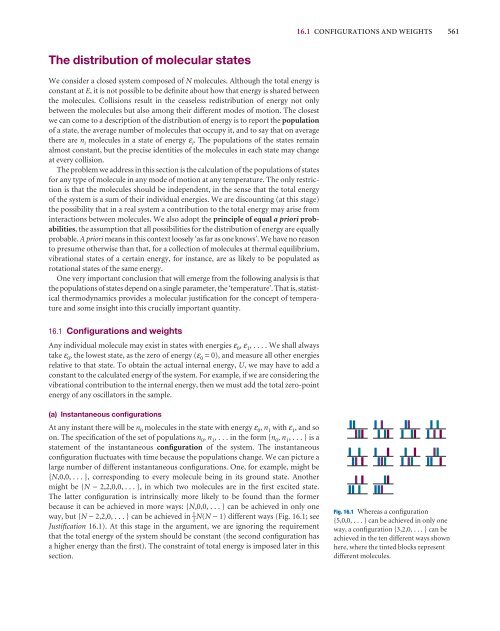Statistical thermodynamics 1: the concepts - W.H. Freeman
Statistical thermodynamics 1: the concepts - W.H. Freeman
Statistical thermodynamics 1: the concepts - W.H. Freeman
Create successful ePaper yourself
Turn your PDF publications into a flip-book with our unique Google optimized e-Paper software.
PC8eC16 1/26/06 14:34 Page 561<br />
16.1 CONFIGURATIONS AND WEIGHTS 561<br />
The distribution of molecular states<br />
We consider a closed system composed of N molecules. Although <strong>the</strong> total energy is<br />
constant at E, it is not possible to be definite about how that energy is shared between<br />
<strong>the</strong> molecules. Collisions result in <strong>the</strong> ceaseless redistribution of energy not only<br />
between <strong>the</strong> molecules but also among <strong>the</strong>ir different modes of motion. The closest<br />
we can come to a description of <strong>the</strong> distribution of energy is to report <strong>the</strong> population<br />
of a state, <strong>the</strong> average number of molecules that occupy it, and to say that on average<br />
<strong>the</strong>re are n i molecules in a state of energy ε i . The populations of <strong>the</strong> states remain<br />
almost constant, but <strong>the</strong> precise identities of <strong>the</strong> molecules in each state may change<br />
at every collision.<br />
The problem we address in this section is <strong>the</strong> calculation of <strong>the</strong> populations of states<br />
for any type of molecule in any mode of motion at any temperature. The only restriction<br />
is that <strong>the</strong> molecules should be independent, in <strong>the</strong> sense that <strong>the</strong> total energy<br />
of <strong>the</strong> system is a sum of <strong>the</strong>ir individual energies. We are discounting (at this stage)<br />
<strong>the</strong> possibility that in a real system a contribution to <strong>the</strong> total energy may arise from<br />
interactions between molecules. We also adopt <strong>the</strong> principle of equal a priori probabilities,<br />
<strong>the</strong> assumption that all possibilities for <strong>the</strong> distribution of energy are equally<br />
probable. A priori means in this context loosely ‘as far as one knows’. We have no reason<br />
to presume o<strong>the</strong>rwise than that, for a collection of molecules at <strong>the</strong>rmal equilibrium,<br />
vibrational states of a certain energy, for instance, are as likely to be populated as<br />
rotational states of <strong>the</strong> same energy.<br />
One very important conclusion that will emerge from <strong>the</strong> following analysis is that<br />
<strong>the</strong> populations of states depend on a single parameter, <strong>the</strong> ‘temperature’. That is, statistical<br />
<strong><strong>the</strong>rmodynamics</strong> provides a molecular justification for <strong>the</strong> concept of temperature<br />
and some insight into this crucially important quantity.<br />
16.1 Configurations and weights<br />
Any individual molecule may exist in states with energies ε 0 , ε 1 ,....We shall always<br />
take ε 0 , <strong>the</strong> lowest state, as <strong>the</strong> zero of energy (ε 0 = 0), and measure all o<strong>the</strong>r energies<br />
relative to that state. To obtain <strong>the</strong> actual internal energy, U, we may have to add a<br />
constant to <strong>the</strong> calculated energy of <strong>the</strong> system. For example, if we are considering <strong>the</strong><br />
vibrational contribution to <strong>the</strong> internal energy, <strong>the</strong>n we must add <strong>the</strong> total zero-point<br />
energy of any oscillators in <strong>the</strong> sample.<br />
(a) Instantaneous configurations<br />
At any instant <strong>the</strong>re will be n 0 molecules in <strong>the</strong> state with energy ε 0 , n 1 with ε 1 , and so<br />
on. The specification of <strong>the</strong> set of populations n 0 , n 1 ,...in <strong>the</strong> form {n 0 , n 1 ,...} is a<br />
statement of <strong>the</strong> instantaneous configuration of <strong>the</strong> system. The instantaneous<br />
configuration fluctuates with time because <strong>the</strong> populations change. We can picture a<br />
large number of different instantaneous configurations. One, for example, might be<br />
{N,0,0, ...}, corresponding to every molecule being in its ground state. Ano<strong>the</strong>r<br />
might be {N − 2,2,0,0, ...}, in which two molecules are in <strong>the</strong> first excited state.<br />
The latter configuration is intrinsically more likely to be found than <strong>the</strong> former<br />
because it can be achieved in more ways: {N,0,0, ...} can be achieved in only one<br />
way, but {N − 2,2,0, ...} can be achieved in – 1 2<br />
N(N − 1) different ways (Fig. 16.1; see<br />
Justification 16.1). At this stage in <strong>the</strong> argument, we are ignoring <strong>the</strong> requirement<br />
that <strong>the</strong> total energy of <strong>the</strong> system should be constant (<strong>the</strong> second configuration has<br />
a higher energy than <strong>the</strong> first). The constraint of total energy is imposed later in this<br />
section.<br />
Fig. 16.1 Whereas a configuration<br />
{5,0,0, ...} can be achieved in only one<br />
way, a configuration {3,2,0, ...} can be<br />
achieved in <strong>the</strong> ten different ways shown<br />
here, where <strong>the</strong> tinted blocks represent<br />
different molecules.

















